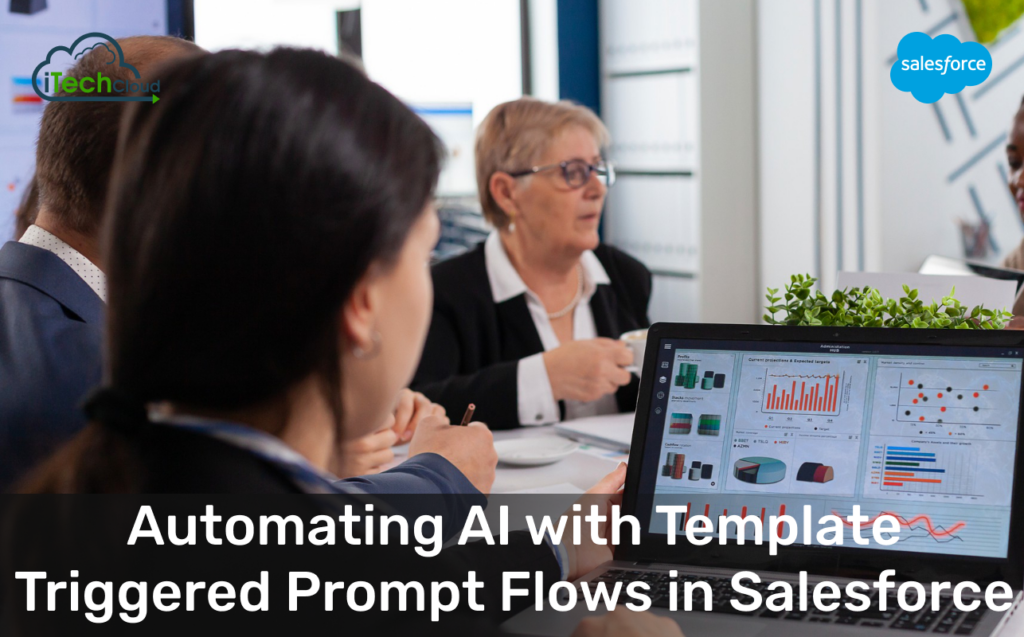Automating AI with Template-Triggered Prompt Flows in Salesforce

Introduction
Artificial Intelligence (AI) is revolutionizing business operations, and Salesforce has emerged as a leader in integrating AI into Customer Relationship Management (CRM). One of the most innovative developments in this space is template-triggered prompt flows, which automate AI-driven interactions within Salesforce.
This blog provides a detailed exploration of how businesses can use template-triggered prompt flows to enhance workflows, improve customer engagement, and boost operational efficiency. We will cover:
Table of Contents
1. Understanding Prompt Flows in Salesforce
What Are Prompt Flows?
Prompt flows are AI-driven workflows that guide automated interactions within Salesforce. They leverage generative AI models (like OpenAI’s GPT or Salesforce Einstein AI) to generate responses, automate tasks, and assist users in real time.
Why Use Prompt Flows?
- Automate Repetitive Tasks: Reduce manual effort in customer service, sales follow-ups, and data entry.
- Enhance Personalization: AI can generate tailored responses based on customer data.
- Improve Efficiency: Streamline workflows by triggering AI actions based on predefined conditions.
Types of Prompt Flows in Salesforce
- Manual Trigger Flows: Activated by user input (e.g., clicking a button).
- Automated Trigger Flows: Run based on system events (e.g., new lead creation).
- Template-Triggered Flows: Use predefined templates to standardize AI interactions.
2. The Role of Templates in AI Automation
What Are AI Prompt Templates?
Templates are structured frameworks that define how AI should generate responses. They ensure consistency, accuracy, and compliance in AI-driven communications.
Benefits of Using Templates
✅ Consistency: Ensures uniform responses across teams.
✅ Compliance: Reduces risks of AI generating inappropriate content.
✅ Efficiency: Speeds up AI response generation by providing a clear structure.
Common Template Structures
- Customer Service Templates: Predefined responses for common queries.
- Sales Outreach Templates: AI-generated email drafts for prospecting.
- Data Enrichment Templates: Structured prompts to extract insights from customer data.
3. How Template-Triggered Prompt Flows Work
Step-by-Step Process
- Trigger Event: A Salesforce event (e.g., new case submission) initiates the flow.
- Template Selection: The system selects a predefined AI prompt template.
- AI Processing: Salesforce Einstein (or an integrated LLM) generates a response.
- Action Execution: The AI response is sent as an email, logged as a note, or used to update records.
Example: Automated Customer Support Response
- Trigger: A customer submits a support ticket.
- Template Used: “Respond to a support request with a personalized acknowledgment.”
- AI Action: Generates a reply like, “Hi [Customer Name], we’ve received your request (#12345) and will get back to you within 24 hours.”
- Outcome: Faster response times, reduced agent workload.
4. Use Cases & Business Benefits
Use Case 1: AI-Powered Customer Service
- Scenario: Automate responses to common support queries.
- Benefit: Reduces resolution time by 30-50%.
Use Case 2: Sales & Lead Engagement
- Scenario: AI drafts follow-up emails based on lead behavior.
- Benefit: Increases conversion rates with hyper-personalized outreach.
Use Case 3: Data Enrichment & Insights
- Scenario: AI analyzes customer interactions and suggests next steps.
- Benefit: Improves decision-making with real-time insights.
Business Benefits Summary
✔ Cost Savings: Reduces manual labor in customer service and sales.
✔ Scalability: Handles high volumes of interactions without extra staffing.
✔ Improved CX: Faster, more personalized customer experiences.
5. Implementation Best Practices
1. Define Clear Use Cases
- Identify repetitive tasks that AI can automate (e.g., ticket responses, lead scoring).
2. Develop Structured Templates
- Ensure prompts are clear, compliant, and aligned with business goals.
3. Test & Optimize AI Outputs
- Run pilot tests to refine AI accuracy before full deployment.
4. Monitor & Maintain
- Continuously review AI performance to prevent errors or biases.
5. Train Teams on AI Integration
- Educate employees on how to use and oversee AI-generated outputs.
6. Future Trends in AI-Driven Automation
1. More Advanced Personalization
- AI will leverage deeper customer insights for hyper-targeted interactions.
2. Voice & Multimodal AI
- Salesforce may integrate voice-enabled AI assistants for call centers.
3. Self-Learning AI Models
- AI will continuously improve responses based on real-time feedback.
4. Tighter Compliance & Ethical AI
- Stricter controls to ensure AI-generated content meets regulatory standards.
Conclusion: Template-triggered prompt flows in salesforce
Template-triggered prompt flows are a game-changer for automating AI in Salesforce. By leveraging structured templates, businesses can enhance efficiency, improve customer engagement, and stay ahead in the AI-driven CRM landscape.

